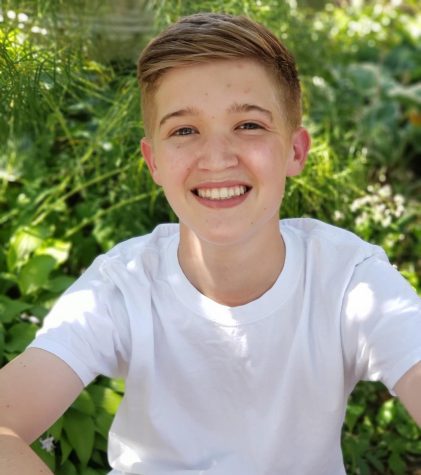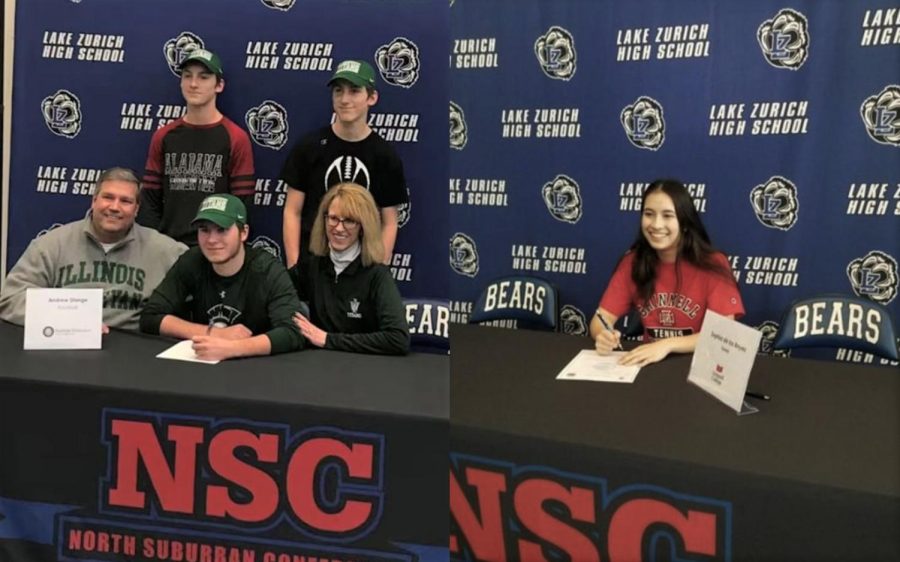The Next Level
Student-athletes reflect on their recruitment process
Photo by Photos used with permission of Andrew Stange and Sophia de los Reyes
Andrew Stange, senior, and Sophia de los Reyes, senior, sign their paperwork on signing day for their college athletics. Stange will be playing football at Illinois Wesleyan University, and de los Reyes will be playing tennis at Grinnell College
460,000 student-athletes currently compete in college athletics, according to the NCAA, and how all of them got to that point is completely different, but there is one thing that connects them all; they all went through the recruitment process.
The college recruitment process does not go the same for every athlete, however, factors such as the sport, size of the school, and the caliber of their play affects how each athlete’s recruitment process works.
Although recruiting follows no template or step by step process, there are checkpoints that are similar within athletes’ experiences.
Starting the process
Some athletes start their recruitment processes by attending scouting camps. Andrew Stange, senior football player who was recruited by Illinois Wesleyan University, started his process by attending camps like these the summer before his senior year.
“There will be a lot of coaches there looking at you like they take your stats and just talk to you there,” Stange said. “That’s kind of where it all starts and it continues through the season.” However, it took coaches until the beginning of football season to approach Stange about playing college football, as he was first approached during a typical college visit.
Clinics and camps are not the universal first step towards the photo op and contract on signing day. There are also websites where athletes can upload footage of their in-game highlights as well as practice film. College coaches can then use these sites to discover recruits as Sophia de los Reyes, senior tennis player who was recruited by Grinnell College, used ncsasports.com to get recruited.
“You can create a profile on there and put up videos of you playing your sport and practicing. Colleges will actually use that site to recruit you and contact you,” de los Reyes said. “They can also use that to get my email, so I got a lot of emails also.”
Visiting Schools and Meeting with Coaches
Recruitment is equally as much about how the athlete perceives the program as it is how the program perceives the athlete. This is why the interviews between coaches and athletes as well as the visits occur, de los Reyes said.
“They’d ask me questions and then I’d ask them questions about the college. I would then evaluate the coach for tennis and see if I would like to be coached by them. Then I’d look at the college and decide whether I wanted them or not,” de los Reyes said. “It was a lot of phone calls and emails, and then I narrowed it down to a 30 school list and kept narrowing it down based on consequent calls and doing deeper research into the college and academics.”
Many schools at the Division I (DI) level can offer their top recruits full scholarships and roster spots should they choose that school, but at a lower level of play like Division III (DIII), schools can’t offer that, according to Stange.
“In a DIII college, they aren’t allowed to give you a athletic scholarship. They have to wait for the school to accept you first,” Stange said. “I had already talked to the coach about playing football there so I already knew that I could play so it was just a matter of getting in. The football coach helped me out and I got in in February.”
The process of having a roster spot available should the athlete be accepted to the school was also similar to de los Reyes. Coaches would be there to help you in the admissions office, de los Reyes said.
“Usually they ask for you to do early decision because there is a higher acceptance rate and then the coach will talk to the admissions board for you and act as an amicus curiae, [an impartial advisor], to see if they want you to retake the SAT or if they like you or whether they want you,” de los Reyes said. “With my coach at Grinnell,’ she said, ‘I have the early decision spot open for you,’ and I said ‘yeah, I’ll take it’.”
Committing and the The Next Step
Once committed, the real work begins. Once athletes graduate from high school, they are expected to adhere to summer workouts and report early for school.
According to de los Reyes, there is already a summer workout program ready for her, she just cannot start before graduation due to NCAA rules. For Stange, football camp at Illinois Wesleyan will start in July.
It is motivation that causes students to want to continue at the next level and practice non-stop because college athletics are a major time commitment, Andrew Lambert, athletic director, said. “Every kid is motivated differently about what they want to do. Some enjoy the sport so much that this is their opportunity to keep playing, and some have aspirations to go professional,” Lambert said.
While some aspire to play professionally, others might feel like they need to keep playing so they could go to college. For de los Reyes, it’s a matter of not wanting to cease the game that brings her joy.
“It was more me not wanting to end playing tennis. I love it so much that I want to continue it in college,” de los Reyes said. “I’ve always been able to get build confidence in myself and pushing myself and seeing what I can do when I put my mind to things.”

As a senior, this is Alex's third year on staff and fourth year in the journalism program. He is very excited to work as the Sports Editor again. When...

